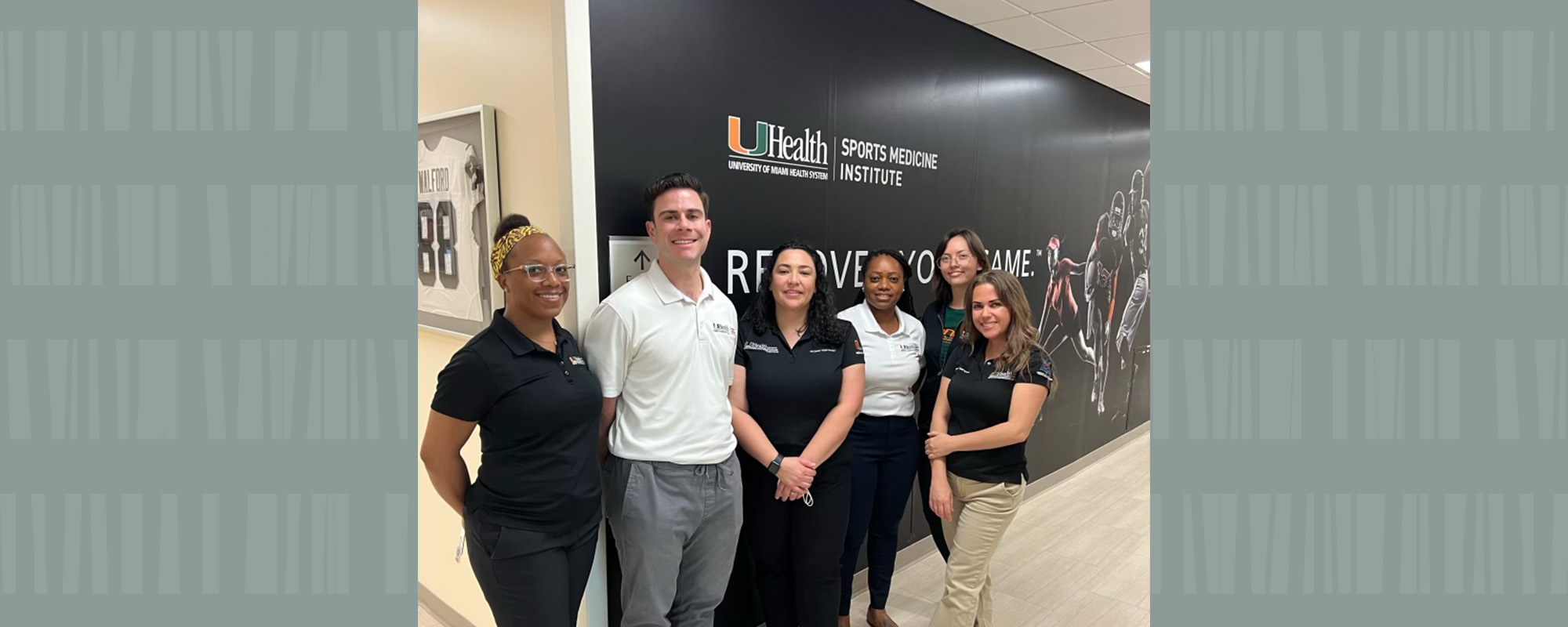What Does an Athletic Trainer Do?

When you hear “athletic trainer” (AT), where does your mind go? 1) a personal trainer who motivates you to do crunches; or 2) a person who works with elite sports professionals?
If you answered 1 or 2, think again.
“We’re multifaceted health care clinicians who can work in any setting, from an orthopaedic or sports medicine clinic to schools and industrial settings. We evaluate acute injuries at the moment they happen, as well as chronic injuries. We see both the general population and athletes at all stages,” says Jesica Brown, MPS, LAT, ATC, a certified athletic trainer and senior practice manager at the Sports Medicine Institute at the University of Miami Miller School of Medicine. The Institute is part of the Department of Orthopaedics at the Miller School of Medicine.
Brown is one of 11 ATs working in the clinic with doctors, physician assistants, physical therapists, and other health care providers. Athletic trainers help people prevent and heal injuries and reduce their chances of re-injury.
No two days are alike for athletic trainers.
At most appointments, patients see an AT and physician.
“In our clinic, athletic trainers are the first person to evaluate the patient,” Brown says. “We take a history of the patient’s injury, perform a physical exam, and present the information to the doctor. We take notes during the visit, demonstrate exercises to patients, and place orders for X-rays and other tests if needed. We can fit patients for braces and other supportive devices, and we answer additional questions they may have after the doctor leaves.
“We’re basically physician assistants; we can do everything except prescribe orders and medications under our own name.”
(ATs can prescribe with a doctor’s order under the doctor’s name.)
What does it take to become an athletic trainer?
It requires a significant investment of time and training to become an AT. According to the National Athletic Trainers Association, ATs must graduate from an accredited master’s program. They receive education in five areas of patient care:
- Prevention
- Clinical evaluation and diagnosis
- Immediate and emergency care
- Treatment and rehabilitation
- Organization and professional health and well-being
In addition to academics, ATs spend a significant amount of time in firsthand clinical experience.
“Clinical rotations can take place in an orthopaedic, sports medicine, or physical therapy clinic, or in high schools and colleges where sports are played,” says Brown.
After completing clinical and classroom hours, students must pass a board exam to become certified and licensed to practice.
The commitment to learning doesn’t end there. ATs complete numerous hours of continuing education throughout their career and learn on the job.
“We never stop learning and growing,” Brown says.
The best part of an athletic trainer’s job?
“I like being able to help people, whether they want to get back to running a marathon or just perform activities of daily living like getting down the stairs pain-free,” Brown says. “Collaborating with our physicians to get patients back to their favorite activities is what’s important to me.”
The Institute sees people from ages 10 and up. “There’s no age limit,” Brown says.
On any given day, she might work with the Institute’s pediatric specialist to heal a Little Leaguer’s pitching arm. She might partner with a shoulder specialist to help an 80-year-old recuperate from shoulder replacement surgery or a 40-year-old heal from a rotator cuff tear.
Plenty of young athletes walk through her doors. The Institute is the official sports medicine provider for the University of Miami Hurricanes, Miami Marlins, and the U.S. Sailing Team. It is also the only academic-based sports medicine program in South Florida that is part of a comprehensive orthopaedics department.
Whether your injury resulted from a weekend warrior accident, years of repetitive work in an industrial setting, or under the glare of Friday night lights, athletic trainers are key to your multidisciplinary care.
To make an appointment at the Sports Medicine Institute’s Coral Gables or Plantation location, call 305-689-5555 (Option 2) .
Nancy Moreland is a regular contributor to UMiami Health News. She has written for several major health care systems and the CDC. Her writing also appears in the Chicago Tribune and U.S. News & World Report.
Tags: athletic injuries, health care team, injury prevention, Jesica Brown, rehabilitation programs for injured, sports medicine in miami
